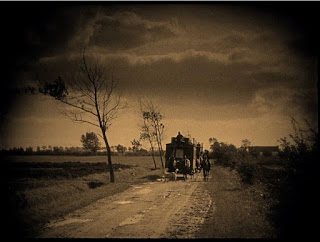Mankind is a state of mind. Man is no more or less
than he thinks himself to be.
This film was produced and directed by Wesley Barry who
was a silent film child star featuring in films such as Dinty (1920)
with Colleen Moore, Noah Beery and Anna May Wong. Four decades later he was an
experienced assistant director in his mid-fifties having worked consistently
behind the camera since his acting roles dried up in the thirties; not a
“victim” of the switch to sound perhaps just growing up and the more
competitive environment.
This film is one of those he’s chiefly remembered by as a
director and, having expected a cheesy low budget generic sci-fi shocker, The
Creation of the Humanoids turns out to be rather more thoughtful and
interesting. It’s a very dialogue-heavy production and more than a tad slow,
but the acting is of a fair standard, there’s plenty of strangeness including
an electronic score from co-producer Edward J. Kay and it raises some
interesting questions about artificial intelligence, the laws of robotics and
the future of mankind. Philip K Dick wouldn’t publish Do Androids Dream of
Electric Sheep? until six years later and it shares the central concerns of
Jay Simms original story and script.
Wesley Barry worked on a budget and his experience shows
in getting the most out of an obviously limited spend for sets and costumes;
there’s the odd special effect – a robot arm flopping on a laboratory table –
but mostly it’s just lighting and acting. Barry worked in TV a lot and it shows
with a film that could easily have been condensed into an episode of The
Twilight Zone. Still, it’s fascinating to see what the freckle-faced youngster
from Dinty did next.
It’s the near-ish future and mankind has almost mutually
assured its own destruction following a nuclear war. As birth rates decline
scientists develop more and more sophisticated robots to fill the gaps in human
capital. They make these more and more like humans in order to make integration
easier but there are some who worry that this assimilation will lead to
domination and The Order of Flesh and Blood has been set up to undermine the
development of more “human” robots, resorting to terrorism and subterfuge in
the battle against the so-called “clickers”.
You hold meetings. Wear ridiculous clothes. You tell
yourselves how superior we are to the robots, because you know we're not.
Our nominal hero is Captain Kenneth Cragis (Don Megowan)
a senior member of the Order who holds a high rank in society. The film plays
with our expectations throughout; is this an “Invasion” from within by advanced
humanoids and are they intent on replacing “us” or just enhancing our
existence. Cragis is arrogant and forceful, certain of his mission to defend
the purity of the human race against the advances of non-human science.
 |
| David Cross, Don Megowan and Frances McCann |
At one point he discovers that his sister, Esme (Frances McCann) has formed a relationship with a humanoid and there’s a
very odd discussion in her apartment as the three of them discuss this with the
clicker, Pax (David Cross) switching between subservience and reasoning with
his partner’s brother. All quite off hand in a way and yet quite astonishing
for the time when you think of the mechanics…
The problem for the Order and Cragis is that the science
is moving far to swiftly for them and a scientist, Doctor Raven (Don Doolittle,
who’s shock of grey hair make him look like a boffin from EC Comics' Weird Science). Raven has worked out how to transfer the consciousness of recently
deceased humans into advanced robots – a "thalamic transplant" –
which creates a hybrid that, mechanics aside, is an exact replica of the
person. With the humanoids, Dr Raven is secretly replacing the human population
with these replicas; some of whom may not be aware of what they are…
 |
| Don Doolittle and Dudley Manlove |
The leaders of the Humanoids are emotionless and see only
the logical imperative for their actions as they convert more and more in their
“temple”. George Milan is Acto and Dudley Manlove plays Lagan, both acting
impassively through their blue/grey "synthe-skin", metallic contact
lenses and grey body suits.
As if to emphasis Cragis’ “last man on earth” qualities
he meets a young woman, Maxine Megan (Erica Elliot) and the two very quickly
fall in love. What could be more human as Man fights for the survival of the
race….
 |
| Don Megowan and Erica Elliot look to the future |
It’s probably not too much of a stretch to see this film
carry echoes of the civil rights movement of the time. A segregated society
concerned with assimilation and an underclass that two objected to being
nicknamed as the “clickers” were. It’s interesting to see what Wesley “did
next” and, this film is worth watching for novelty value alone. Like all good
science fiction/fantasy it’s not really about tomorrow, it’s about today.


















































+colour.png)








